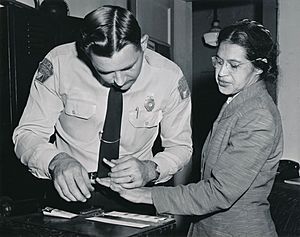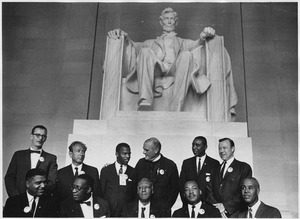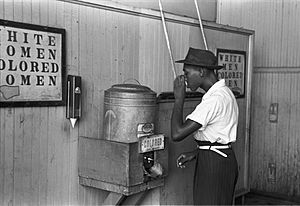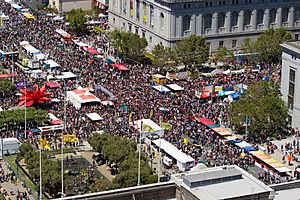Civil rights movements facts for kids
The civil rights movements are important political actions around the world. Their main goal is to make sure everyone has equal civil and political rights. Throughout history, people have used different ways to fight for these rights. Sometimes, they used nonviolence, which means protesting peacefully without hurting anyone. Other times, people rebelled, which could involve violence. Many of these movements did not reach all their goals right away. However, they often took big steps toward making society more fair.
The main idea behind civil rights movements is that the law should protect everyone's rights equally. This includes the rights of minority groups. Civil rights movements look different in each country. Today, movements for LGBT rights, women's rights, and the rights of many racial minorities are still working to achieve full equality.
Contents
Fighting for Freedom in Africa
Many African countries fought for their freedom from European control. These struggles were also about civil rights, as people wanted to govern themselves.
Angola's Fight for Independence
The Angolan War of Independence happened from 1961 to 1975. During this time, Angola fought against Portugal. Portugal had forced people in Angola to farm cotton. Three different groups in Angola worked to gain freedom from Portugal. Millions of people died during this long war.
Guinea-Bissau Gains Freedom
Before 1974, Portugal also controlled a place called Portuguese Guinea. From 1963 to 1974, the people in Guinea fought for their independence in the Guinea-Bissau War of Independence. In 1974, they won their freedom and formed the country of Guinea-Bissau.
Mozambique's Struggle for Rights
The Mozambican War of Independence took place from 1964 to 1975. It was a fight between Portugal, which ruled Mozambique, and the Mozambique Liberation Front, also known as Frelimo. Even though the Portuguese won some battles, a change in government in Portugal led to Mozambique becoming independent on June 25, 1975.
Civil Rights in Ireland
In Northern Ireland, people also started movements for equal rights.
The Campaign for Social Justice began in Belfast in 1964. Soon after, the Northern Ireland Civil Rights Association (NICRA) was formed. These groups wanted several important changes:
- They wanted to get rid of certain old laws that gave special powers to the government.
- They wanted to end a special police force called the B Specials.
- They wanted fair elections and to stop unfair voting districts (called gerrymandering).
- They wanted to end unfair treatment in housing and government jobs.
These demands for reform caused problems with some people in the majority group. This led to a long period of conflict called The Troubles, which lasted for over 30 years.
The NICRA used peaceful methods, much like the American Civil Rights Movement. They organized nonviolent marches, pickets, sit-ins, and protests. The first civil rights march in Northern Ireland happened on August 24, 1968, between Coalisland and Dungannon.
The Civil Rights Movement in the United States
The United States had its own very important civil rights movements, especially for African Americans.
Ending Segregation
Segregation was a system where white people in the Southern United States tried to keep races separate. They did this to keep power over African Americans. This system was often called the Jim Crow system.
Segregation became common in Southern states after 1877, following the Civil War (1861-1865). During a period called Reconstruction, African Americans had gained more opportunities. But after 1877, new laws were passed that said certain places were "For Whites Only" and others were "For Colored." African Americans had separate schools, transportation, restaurants, hospitals, and parks. These separate places were usually not as good as the white-only ones. For about 75 years, Jim Crow signs separated people everywhere.
The segregation system also stopped African Americans from voting. This was called disfranchisement. Between 1890 and 1910, Southern states passed laws that made it very hard for black people to vote. For example, some laws required people to be able to read and write to vote. Many African Americans did not have access to education or property. Because they could not vote, they had little power to stop unfair treatment in public places, schools, jobs, or housing.
In Northern states, conditions for African Americans were a bit better. They could usually vote, but there were fewer black people, so their voices were not always heard. Segregated places were less common in the North. However, black people were often not allowed into the best hotels and restaurants. Schools in New England usually had both black and white students, but schools in the Midwest often did not.
The Montgomery Bus Boycott

On December 1, 1955, Rosa Parks, a member of the National Association for the Advancement of Colored People (NAACP) in Montgomery, Alabama, was told to give up her seat on a city bus to a white person. When she refused, she was arrested. Local civil rights leaders saw this as a chance to protest unfair bus rules. The black community in Montgomery had been angry for a long time about how they were treated on buses.
The Montgomery Bus Boycott was a huge success. About 50,000 black people in Montgomery supported it, and it lasted for over a year. This event showed the American public that black people in the South would keep protesting until segregation ended. In November 1956, a federal court ordered Montgomery's buses to end segregation. The boycott ended with black people winning the right to sit wherever they wanted.
A young Baptist pastor named Martin Luther King Jr., led the Montgomery Improvement Association, which organized the boycott. This protest made King a well-known leader. He later became the president of the Southern Christian Leadership Conference (SCLC) in 1957. The SCLC encouraged nonviolence, using marches, demonstrations, and boycotts. The strong reactions from some white people to these peaceful protests eventually made the government address unfairness and racism in the South.
King had many followers among black people. He also gained support from people in the North who believed in fairness. His belief in nonviolence attracted people who wanted peace. He also worked with the American Jewish community and wealthy Protestant churches in Northern cities. King often spoke at these churches, raising money for the SCLC.
The Chicano Movement
The Chicano Movement was a political, social, and cultural movement for Mexican Americans. This movement worked to change negative ideas about Mexican people in the media and among other Americans. People like Tiburcio Vasquez and Joaquin Murietta became folk heros to Mexican Americans because they stood up against unfair treatment.
The American Indian Movement
The American Indian Movement (AIM) is a Native American activist group in the United States. It was started in 1968 in Minneapolis, Minnesota. The group was formed to help with problems faced by Native Americans living in cities. They wanted to stop poverty, improve housing, address treaty issues, and end police harassment.
Gender Equality and Women's Rights
The first major issue for feminism was suffrage rights, which led to women getting the right to vote. Later, women fought for economic equality, like getting paid the same as men for doing the same job.
LGBT Rights and Gay Liberation
In 1996, the United States Congress created the Defense of Marriage Act. This law stopped the federal government from recognizing same-sex relationships for marriage. Over time, many states passed laws banning same-sex marriage. However, some states like Connecticut, Massachusetts, New Mexico, New Jersey, New York, Rhode Island, and Vermont made gay marriage legal.
Before 2011, gay and lesbian people were not allowed to openly serve in the United States military. Under a rule called "Don't ask, don't tell" (DADT), they could serve only if they did not tell anyone about their sexual orientation. The "Don't Ask, Don't Tell Repeal Act of 2010" changed this. Since September 20, 2011, gay, lesbian, and bisexual people have been able to serve openly in the armed forces.
Some groups in the United States have opposed gay rights, often for political or religious reasons. These groups are mostly found in the South and rural areas.
Civil Rights in Germany
The Civil Rights Movements in Germany were a reaction against the time after the Nazi Party era. This movement mostly involved students who felt unhappy with society. It was part of a larger wave of protests happening around the world in the late 1960s.
Civil Rights in France
In May 1968, a huge general strike broke out across France. It became a major challenge to the government. Even though the French Communist Party tried to stop it, the government eventually ended the protests. Some thinkers believe this rebellion was one of the most important revolutionary events of the 20th century. This is because it involved people from all parts of society, not just one group, showing a widespread desire for change.
Images for kids
-
Jesse Jackson fought for civil rights as his life's work.
See also
 In Spanish: Movimiento por los derechos civiles para niños
In Spanish: Movimiento por los derechos civiles para niños







